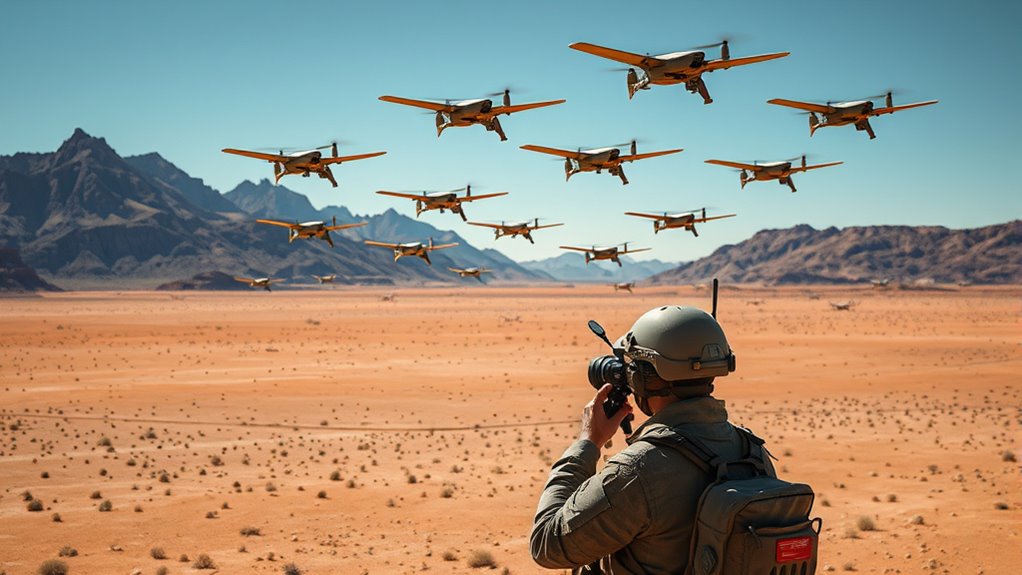Military forces are testing drone swarms powered by AI that can coordinate and carry out complex attacks independently. These autonomous drones communicate in real-time and adapt quickly to battlefield changes, offering faster response times and reducing risks to soldiers. While promising, there are ethical and security concerns about accountability, hacking, and system reliability. If you keep exploring, you’ll discover more about the challenges and implications of this cutting-edge technology.
Key Takeaways
- Militaries are testing AI-controlled drone swarms capable of autonomous attack coordination.
- These drone systems utilize sophisticated algorithms for real-time decision-making and adaptive strategies.
- The development aims to enhance response speeds and reduce risks to human soldiers in combat.
- Challenges include ensuring secure communication, preventing hacking, and maintaining system reliability.
- Ethical concerns revolve around accountability, moral limits, and adherence to international humanitarian laws.

Military researchers are making significant strides in drone technology by testing swarms controlled through artificial intelligence. These swarms consist of numerous small drones working together autonomously, capable of executing complex attack strategies without direct human intervention. As you follow these developments, it’s important to contemplate both the incredible technological advancements and the complex ethical implications that come with deploying such autonomous systems. The goal is to create coordinated units that can adapt to changing battlefield conditions swiftly, but this progress doesn’t come without significant technological challenges. Guaranteeing reliable communication among drones in real-time, maintaining precise coordination, and preventing system malfunctions are ongoing hurdles that researchers are actively working to overcome. The complexity of programming AI to handle unpredictable scenarios safely and effectively remains a major obstacle, requiring sophisticated algorithms that can make split-second decisions while avoiding unintended consequences.
As you explore deeper into this technology, you’ll realize that these drone swarms have the potential to revolutionize military operations, offering faster response times and reducing risks to human soldiers. However, deploying AI-controlled attack units raises critical questions about accountability and the moral limits of autonomous warfare. The ethical implications are vast: should machines be allowed to make life-and-death decisions, and who is responsible if an autonomous drone causes unintended harm? These are questions that military organizations, policymakers, and ethicists are grappling with as they develop frameworks to regulate autonomous weapons. The concern is that, without clear rules, the use of AI in attack scenarios could lead to miscalculations or misuse, escalating conflicts or causing civilian casualties. You must acknowledge that the development of these systems demands careful oversight to prevent their misuse and ensure compliance with international humanitarian laws.
Despite the promising capabilities, technological challenges persist. Achieving seamless coordination among hundreds of drones in real-time, ensuring secure communication channels, and preventing hacking or malicious interference are significant issues that need solutions. Furthermore, integrating AI that can interpret complex battlefield data and adapt strategies accordingly remains a work in progress. As you follow this advancement, it’s clear that balancing innovation with ethical responsibility is paramount. While the technology offers strategic advantages, it also compels you to consider the broader consequences of autonomous warfare—its impact on international stability, civilian safety, and the future of conflict. Additionally, advancements in Vetted Halloween Product Reviews reflect ongoing trends in consumer safety and quality assurance, emphasizing the importance of trustworthy information in technology and product development. In short, as military researchers push forward, they must also navigate the moral landscape and technological barriers involved in deploying AI-driven drone swarms on the battlefield.
Frequently Asked Questions
How Do Drone Swarms Communicate Securely During Missions?
You guarantee secure communication during drone swarm missions by implementing advanced encryption protocols that protect data from interception. You also maintain signal integrity through robust frequency hopping and error correction techniques, preventing jamming and ensuring reliable command and data exchange. By continuously monitoring and updating these security measures, you keep the swarm’s communications resilient against cyber threats and interference, enabling coordinated and safe autonomous operations.
What Ethical Concerns Are Associated With Autonomous Drone Attacks?
You should consider the moral implications of autonomous drone attacks, as they raise questions about accountability and the potential for unintended harm. Legal challenges also emerge, since it’s unclear who’s responsible for decisions made by AI in combat. These concerns highlight the importance of establishing ethical frameworks and regulations to guide the development and deployment of such technology, ensuring it aligns with international laws and human rights standards.
Can Drone Swarms Adapt to Unexpected Battlefield Changes?
Think of drone swarms as a river that constantly adapts to its banks. Yes, they can adapt to unexpected battlefield changes through advanced swarm coordination, but their battlefield adaptability depends on real-time data and AI algorithms. While they can respond to certain surprises, unforeseen complexities might challenge their flexibility. You should consider that the more unpredictable the environment, the more vital it becomes to upgrade their decision-making capabilities.
How Is AI Ensured to Prevent Friendly Fire Incidents?
You ensure AI prevents friendly fire by implementing AI decision transparency, so you can understand how it makes choices. You also focus on battlefield AI ethics, setting strict rules for the drone swarms to distinguish between friend and foe. Regular testing and updates help refine these systems, guaranteeing the AI’s actions align with ethical standards. By doing so, you reduce risks and maintain control over autonomous operations.
What Are the Limitations of Current Drone Swarm Technologies?
Imagine a flock of birds trying to fly in perfect harmony, but sometimes, communication glitches cause confusion. That’s the limit of current drone swarm technologies. Swarm coordination relies heavily on AI decision making, yet it struggles with unpredictable environments, signal interference, and complex terrain. These factors can cause delays, misalignment, or unintended actions, highlighting the need for further advancements before drones can fully operate seamlessly in dynamic combat scenarios.
Conclusion
As you watch these advancements unfold, it’s like witnessing a new chapter in the age of Icarus—where innovation soars ever higher, but risks remain. Just as Daedalus warned of the dangers of unchecked ambition, today’s military tests remind us to tread carefully with autonomous tech. While these drone swarms showcase incredible power, they also challenge us to contemplate the ethical skies we’re flying into, urging caution before reaching too close to the sun.











